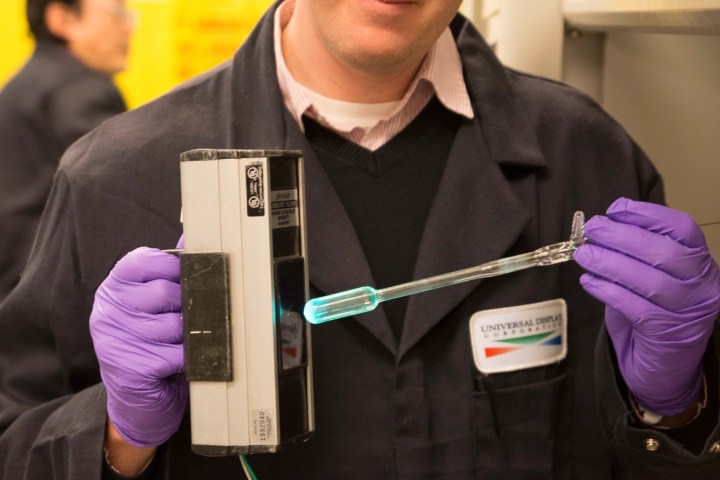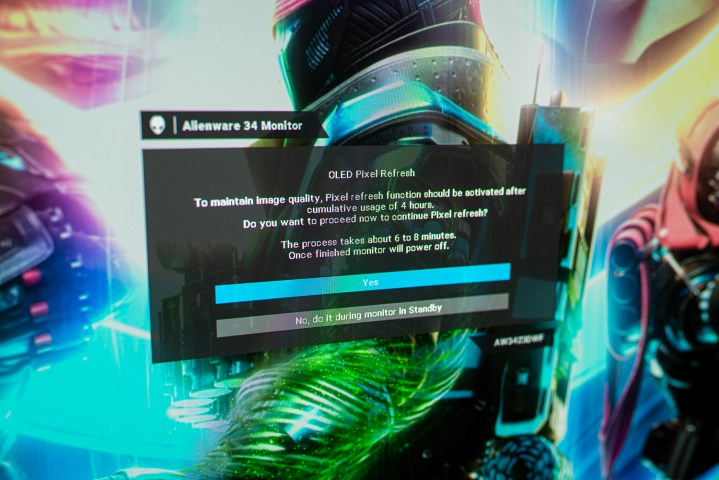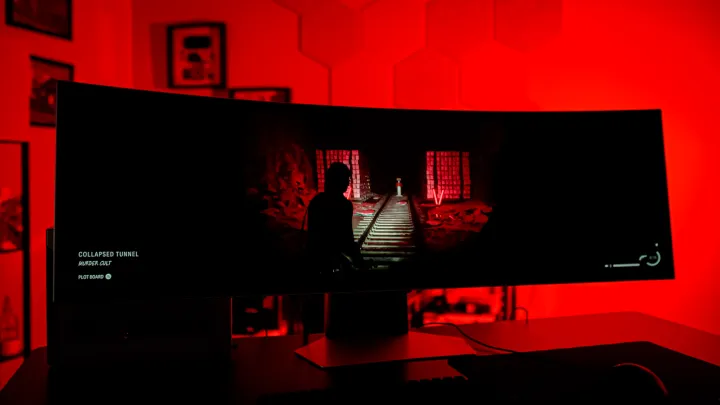
“That’s just too dim.”
It’s the same feedback I always get when reviewing OLED gaming monitors, which have made waves throughout this year. The criticism puts a damper on the otherwise jaw-dropping color and perfect contrast. The brightness measurements certainly seem to affirm that suspicion, showing they sometimes provide more than half as much brightness of a traditional LCD display. But are they really too dim?
To better understand how OLED differs, I talked with Jacky Qiu, vice president and co-founder of OTI Lumionics. OTI doesn’t make panels, but its research of the technology is critical to how OLED is used by major companies today. And according to Qiu, there’s a good reason for the dimness of OLEDs — so be careful what you ask for.
Apples to oranges

OTI is a company that knows OLED inside and out. It’s a materials company, or as Qiu put it, “anything to do with, like, hard science stuff” of OLED technology. Its main claim to fame is CPM patterning, which opens a “window” in the material to place sensors under the display. Qiu pointed to a camera, an IR emitter, and an IR camera for an implementation of Face ID as an example.
But for our purposes, the company investigates the technology of OLED, with backing from companies like Samsung, LG, and the Universal Display Corporation. So, my first question focused on the feedback I always see surrounding the dimness of OLED panels. Qiu pointed to a fundamental difference between LCD monitors and OLED monitors: “For an LCD, you’re essentially having a backlight … and you can just have them as bright as you want.”
As Qiu points out, LCD and OLED are fundamentally different. That sets the comparison between LCD brightness and OLED brightness up for failure: “You’re comparing something that, you know, is used for lighting or something [that] can be very, very bright to something that is OLED, that is basically each individual cell in your monitor is acting as its own individual small light-emitting diode.”
OLED will always be dimmer because it can’t rely on a bright backlight alone. Qiu pointed to LED light bulbs you might have around your house.
“You can light your room with LED light bulbs, so you can just blast that light to be very strong.” LCD monitors with dimming zones then selectively choose where on the screen to blast that bright light, increasing the contrast. Some tech, such as mini-LED, include a huge number of dimming zones to carefully control the contrast.

An OLED display doesn’t work that way. Each pixel is its own self-emitting diode (basically a small channel that can pass electrical current), so you can’t just blast a backlight and get higher brightness. There is no backlight.
Without the backlight of LCD, the next option would be just to send more electrical current through the diode to increase the brightness, but that’s where OLED can run into issues.
Unintended consequences

The first thing you’ll hear about OLED monitors is that they’re too dim. The second thing you’ll hear is that OLED monitors suffer from burn-in. This is where static elements fade into the screen over time, and you can’t get rid of them. Rtings recently published a burn-in report on OLED gaming monitors and found some displays could show burn-in in as little as 700 hours. Stop the presses!
The risk of OLED burn-in is exaggerated. Qui said that most use cases don’t have issues with burn-in.
“Most of the stuff in the field, even from 10 years ago — for example, your PlayStation Vita — the burn-in is not a tremendous issue per the use,” Qiu said. “As long as you’re not basically using your OLED TV to watch CNN or watch sports, like, 24/7, nonstop, the burn-in is not as noticeable.” Qiu was careful to clarify that “we work on OLED, do always take anything I say with a small grain of salt.”
Burn-in is a result of the how much degradation a single diode has undergone. If you have a static element on a set of pixels, they’ll wear down faster showing that single image than the rest of the display, where content and colors are constantly shifting. Modern OLED monitors have ways to get around this risk, though.

Qiu also pointed to how modern OLED displays deal with the risk of burn-in. First is that, while you’re viewing content, the pixels will shift on static elements, attempting to evenly wear down the pixels so burn-in isn’t noticeable. Then, about once a day, the monitor will adjust the voltage threshold to the diodes so that they’re uniform. And finally, after about every 1,000 hours of use, the panel will go through every diode and refresh them for uniformity across the screen. The material is still degrading, there’s no way around that. But these features ensure that the degradation is even so you don’t ever see any nasty burn-in.
All of this effort is to delay the inevitable death of the organic material that makes up OLED. It will degrade over time, but as long as the degradation is uniform, you shouldn’t notice burn-in.
The brighter the display, the larger the risk of burn-in becomes.
How does this factor into brightness? You can’t avoid degradation, but that process is sped up by feeding the diodes more current and increasing their brightness. “You basically make the choice of either going brighter or having a longer lifetime,” says Qiu. “It’s typically a trade-off.”
As an example, Qiu pointed to theoretically increasing the brightness by 20%. “The end consumers want it to be 20% brighter, right? So it could be, instead of it needing to be 20% brighter, it could have 1.5x longer lifetime.”
The risk of burn-in becomes much more real then. Instead of looking at a life span of six years, you might be looking at a life of only a couple of years. OLED makers need to balance the brightness with longevity.
This isn’t a new problem, either. I was talking with Digital Trends’ resident TV expert Caleb Denison, who told me that LCD panels have similar problems when increasing the brightness of the backlight. It’s not burn-in that LCDs face, but a drop in image quality as the brightness goes up. LCD and OLED are fundamentally different in how they approach brightness, but they both have to deal with balancing brightness against other factors.
Perception vs. reality

OLED monitors will always be dimmer than LCD, but you don’t need to succumb to burn-in to have an enjoyable experience. The actual brightness put out by OLED is lower, but that’s not what your eyes perceive.
Qiu pointed to something that, by his own admission, he’s not an expert in. But it holds a lot of truth. “If you use OLED, basically, because it’s a self emitter, you can have sharper contrast that can give you an effect of higher perception of brightness.”
Brightness needs context, and context is thrown out the window when comparing two numbers pulled from a luminance meter. OLED is dimmer, but does it actually look dimmer? In most cases, it doesn’t.
First, contrast. OLED has theoretically infinite contrast, and your eye can only take in so much light at once. A bright, sunny day is much brighter than your 2,000-nit LCD TV, but your TV will probably look brighter in a dark room. There’s more contrast localized to one area. The same is true with OLED. Because the dark parts are so dark, the bright parts look brighter by comparison.
There are several other factors at play with perceived brightness, too. One is how close that source of light is to your eyes. As an example, Caleb brought up having a single light bulb on in a large room. Get right next to it, and you’ll probably damage your eyes. Step a foot away, and you’ll be able to read a book. Go to the other side of the room, and you may not be able to see enough to tie your shoelaces.
The same is true for your monitor. It’s never more than a couple of feet away from your face, so the perception of light is much larger. I asked Caleb about how much viewing distance impacts brightness, and he didn’t mince words. “It’s pretty big, I would say.”
With a gaming monitor, you’re probably sitting no more than two feet away.
Another factor here is how big the light source is. I recently reviewed the Samsung Odyssey OLED G9, and I heard a lot of feedback that it was too dim considering the price. It’s a massive monitor, so it never felt dim because the physical light source is so big. In fact, it felt searingly bright, regardless of what the luminance meter said.
The actual brightness you see depends on several factors: viewing distance, contrast of the screen, color purity, and ambient light. It’s only in that last area where OLED runs into issues.
There is a level in which OLED can’t get bright enough to overcome the ambient light in your room, but that’s only one of several factors that influence how bright a monitor actually looks. And in the context of a gaming monitor, where you’ll probably be sitting no more than 2 feet away without direct sunlight, it’s not much to worry about.
I mean, what’s the worst that could happen? You need to pull a shade?
Editors’ Recommendations
Services Marketplace – Listings, Bookings & Reviews